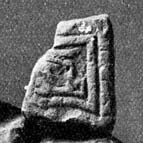Select a site alphabetically from the choices shown in the box below. Alternatively, browse sculptural examples using the Forward/Back buttons.
Chapters for this volume, along with copies of original in-text images, are available here.
Object type: Fragment of cross-arm(?) [1]
Measurements: (after Collingwood 1915b) H. 16 cm (6.25 in); W. Not recorded; D. 13 cm (5 in)
Stone type: Unobtainable. Collingwood (1915b, 288) said it was of red sandstone.
Plate numbers in printed volume: Ills. 519-22
Corpus volume reference: Vol 8 p. 206
(There may be more views or larger images available for this item. Click on the thumbnail image to view.)
The end of one arm of a cross with a cusped terminal, probably of type D9 as Collingwood drew it.
A (broad): The face is edged by a fine double roll moulding. Within this are the remains of a pattern which is really indecipherable. Collingwood (1915b, 288) surmised a possible key pattern, perhaps connecting with a scroll, as on face D of an early ninth-century cross fragment from Dacre, Cumberland (Bailey and Cramp 1988, 90–1, no. 1, ill. 237). All that can safely be said is that there seem to be straight-line terminals at the end of the arm, connecting with other pattern elements nearer the centre.
B (narrow): The end of the arm is plain apart from the double roll mouldings.
C (broad): A curved form filling most of the end of the arm, inside a double roll edge moulding, suggests that this face had a plant-scroll, with a volute in the end of the arm: some rounded forms suggest leaf terminals, one extending into the spandrel between the volute and the lower end corner of the arm.
D (narrow): Missing
E (above arm): Completely plain
F (below arm): Probably the visible underside of the cross-arm: it has double roll mouldings like the other carved faces.
It is difficult to tell with a missing sculpture known only from illustrations, and such a small fragment at that, but the cusped form and delicacy of the carving suggest a late eighth- to early ninth-century date. The span suggested by Collingwood for the completed head — about two feet (60 cm) across — he thought too large for the shaft fragment Leeds 3, as well as being of a different stone type.



